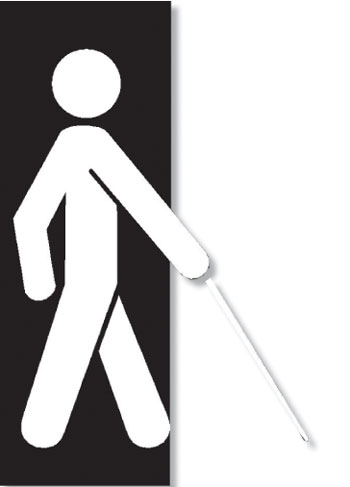Whit Cane Day
 In February of 1978, a young blind lady said, "I encounter people all
of the time who bless me, extol my independence, call me brave and
courageous, and thoroughly miss the boat as to what the real
significance of the white cane is." In February of 1978, a young blind lady said, "I encounter people all
of the time who bless me, extol my independence, call me brave and
courageous, and thoroughly miss the boat as to what the real
significance of the white cane is."
The National Federation of the Blind in convention assembled on July
6, 1963, called upon the governors of the fifty states in USA to
proclaim October 15 of each year as White Cane Safety Day in each of the
fifty States in the US.
On October 6, 1964, a joint resolution of the Congress, HR 753, was
signed into law authorising the President of the United States to
proclaim October 15 of each year as "White Cane Safety Day." This
resolution stated: "Resolved by the Senate and House of
Representatives", that the President is hereby authorised to issue
annually a proclamation designating October 15 as White Cane Safety
Day and calling upon the people of the United States to observe such
a day with appropriate ceremonies and activities.'
Within hours of the passage of the congressional joint resolution
authorizing the President to proclaim October 15 as White Cane Safety
Day, then President Lyndon B. Johnson recognised the importance of the
white cane as a staff of independence for blind people.
In the first Presidential White Cane Proclamation President Johnson
commended the blind for the growing spirit of independence and the
increased determination to be self-reliant that they had shown.
The Presidential proclamation stated: "The white cane in our society
has become one of the symbols of a blind person's ability to come and go
on his own. Its use has promoted courtesy and special consideration to
the blind on our streets and highways.
To make our people more fully aware of the meaning of the white cane
and of the need for motorists to exercise special care for the blind
persons who carry it Congress, by a joint resolution approved as of
October 6, 1964, has authorised the President to proclaim October 15 of
each year as White Cane Safety Day.
Now, therefore, I, Lyndon B. Johnson, President of the United States
of America do hereby proclaim October 15, 1964 as White Cane Safety
Day".

With those stirring words President Johnson issued the first White
Cane Proclamation which was the culmination of a long and serious effort
on the part of the National Federation of the Blind to gain recognition
for the growing independence and self-sufficiency of blind people in
America, and also to gain recognition of the white cane as the symbol of
that independence and that self-reliance.
The first of the state laws regarding the rights of blind people to
travel independently with the white cane was passed in 1930. In 1966,
Dr. Jacobus Broek, the founder of the National Federation of the Blind,
drafted the model White Cane Law.
This model act--which has become known as the Civil Rights Bill for
the Blind, the Disabled, and the Otherwise Physically
Handicapped-contains a provision designating October 15 as White Cane
Safety Day. Today there is a variant of the White Cane Law on the
statute books of every state in the nation.
From 1963 (and even before) when the National Federation of the Blind
sought to have White Cane Safety Day proclaimed as a recognition of the
rights of blind persons, to 1978 when a blind pedestrian met with
misunderstanding regarding the true meaning of the white cane, is but a
short time in the life of a movement. In 1963, a comparatively small
number of blind people had achieved sufficient independence to travel
alone on the busy highways. Now that number has not simply increased but
multiplied a hundredfold. The process began in the beginning of the
organised blind movement and continues today. There was a time when it
was unusual to see a blind person on the street, to find a blind person
working in an office, or to see a blind person operating machinery in a
factory.
This is still all too uncommon. But it happens often and the symbol
of this independence is the white cane.
The blind are able to go, to move, to be, and to compete with others
in society. The means by which this is done is that simple tool, the
white cane.
With the growing use of the white cane, is an added element -'the
wish and the will to be free' - the unquenchable spirit and the
inextinguishable determination to be independent.
With this lives have changed, and the prospects for blind people have
become brighter. That is what White Cane Safety Day is all about.
-Internet |

